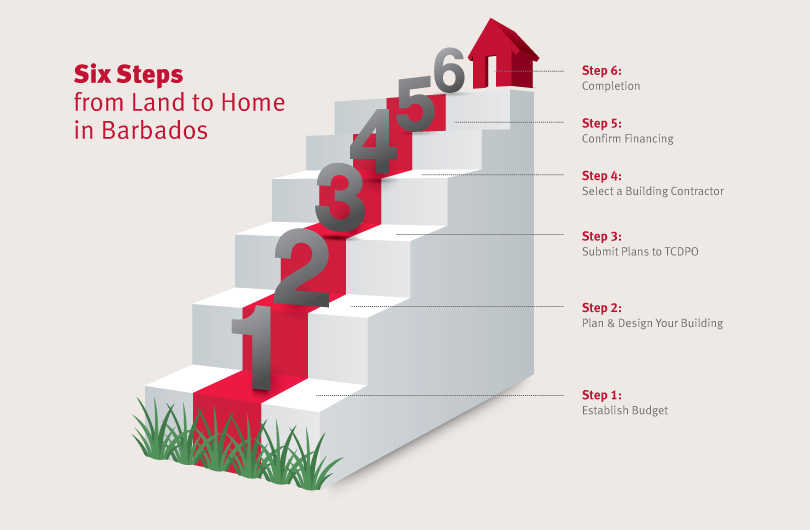From Land to Home
The process of building a home varies amongst the islands of the Caribbean. Below is an example of the typical progression when looking to build in Barbados.

Step 1: Establish Budget
When seeking to establish a budget, you should check around at various financial institutions. They will help you with the level of mortgage for which you may qualify based on your Total Debt Service Ratio.
You should also locate your title deeds, surveyor’s plot plan and your land tax bill as these documents will help you acquire the information necessary to move ahead with your plans. You need to check your deeds to be aware of the covenants attached to the property. Covenants are quite common, especially in new developments, and they contain any limitations to developing the property. A quick call to the Town and Country Development Planning Office (TCDPO) will confirm additional information on restrictions outside of any covenants. Have your Land Tax Reference number handy as this will help to guide the TCDPO Officer.
Step 2: Plan & Design Your Building
Based on your budget, your Architect/Draftsman can derive a rough estimate of your house size by dividing your qualifying loan amount by the build cost per sq. ft. (e.g. US$125) and the result is the total floor area. You will need to supply a copy of the Plot Plan along with a brief of your desired specifications.
The architectural plans should incorporate elements of your brief, and conform to your budget. The process takes approximately four (4) weeks. On completion, the Architect/ Draftsman submits them to TCDPO for approval.
The Architects’ fees are approximately 7% of the value of the property. If you choose to engage a Draftsman to produce your plans, the rates may be lower.
Tip: After the plans have been completed, you may choose to engage a Quantity Surveyor (QS) to cost the project.
Step 3: Submit Plans to TCDPO
The following are required by TCDPO: Location Plan; Elevation Plan of the front of the building and one other side; the Floor Plan; Surveyors Plot Plan and the Site Plan which shows the shape and dimensions of the land and how the building will fit on the land. It is not necessary to have full construction drawings in order to submit your application.
The cost of applying to TCDPO is US$150 for the construction of a 1,500 – 2,000 sq. ft. residence. Applicants can check the status of their applications on the TCDPO website.
After planning approval has been received, you must apply for a building start letter from TCDPO which costs US$50. An officer will visit the site and ascertain that the property is laid out in accordance with the approved plan. Once the confirmation letter is issued, you can commence building.
Step 4: Select a Building Contractor
It is recommended that you obtain quotations from at least three Contractors, get referrals and examine other work that they performed. Your Architect may also help you with identifying Contractors. When the Contractor has been chosen, a written contract should be negotiated. The contract essentially describes the responsibilities of each party, and the rules for resolving disputes. It documents all elements of the work and includes an agreed payment scheme. The most common payment scheme in the construction industry is payment in stages where the Contractor is paid on completion of specific stages. The QS would check the work completed by the Contractor, prepare a cost valuation and submit reports for stage payments. A QS’s fee is approximately 2% of the value of the job.
A construction contract can be obtained from the Barbados Association of Quantity Surveyors for US$8.
Tip: Remember to include a defect liability period in the contract, which allows you to retain five percent (5%) of the Contractor’s fee until an inspection has been carried out to ensure that the building does not have defects.
Step 5: Confirm Financing
After you have been approved by a financial institution for a mortgage to construct a house, you will be issued a commitment letter. Your financiers will then proceed to setup a Bridging Loan. This is an interest only facility during the stages of construction and is at a higher rate of interest, as a result of the increased risk. On completion of each stage of the work, the bank requires an Approved Stage Inspection Report before disbursing further funds. Disbursements would normally be made to you, however, you can instruct the bank in writing, to make the payments directly to the Contractor.
Tip: Keep in mind that the loan application process can be lengthy but you need to be patient and try not to be pressured into commencing building using your own funds while you are waiting to finalise the financing.
Step 6: Completion
Once construction is completed you should request a Certificate of Compliance (fee of US$75) from the TCDPO verifying that the project has been satisfactorily completed.
At this point your loan is converted to a full mortgage after conditions are met on submission of the following: evidence of comprehensive insurance on the finished house; your life insurance; the Certificate of Compliance; and a market valuation certifying that the house is completed and stating its current value. Once all criteria have been met and the mortgage document has been implemented, your monthly payments will commence.
Tip: Remember to keep hard copies (electronic copies if possible) of all documents used on your project.




Thank you for being so transparent and making the different stages in construction so understandable . Also the difference in the cost of drawings by an architect vs. a draughtsman.